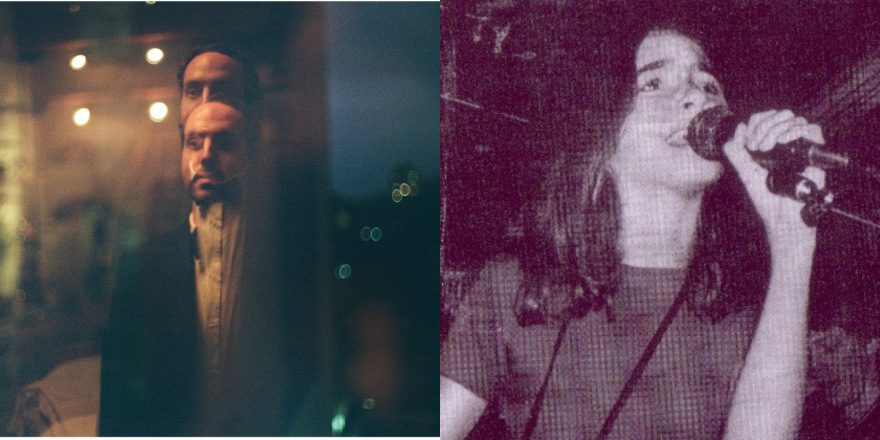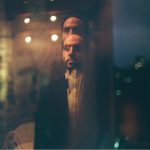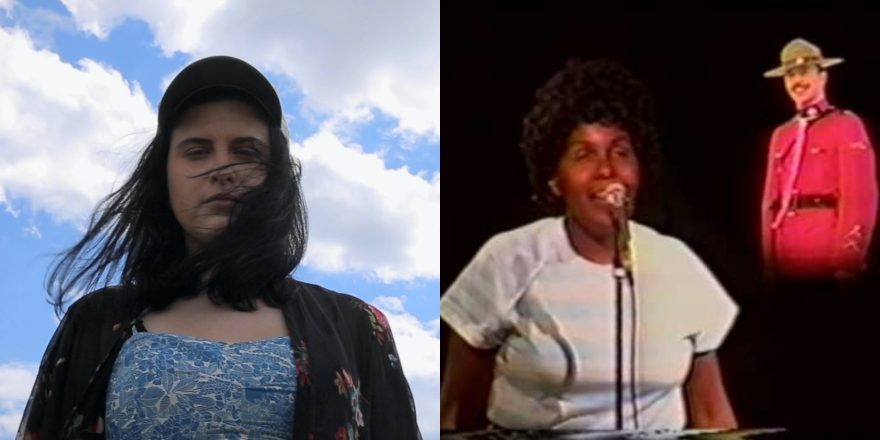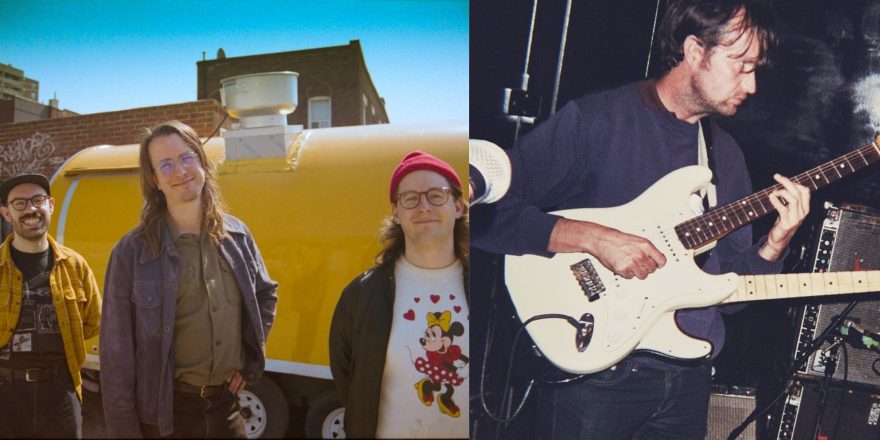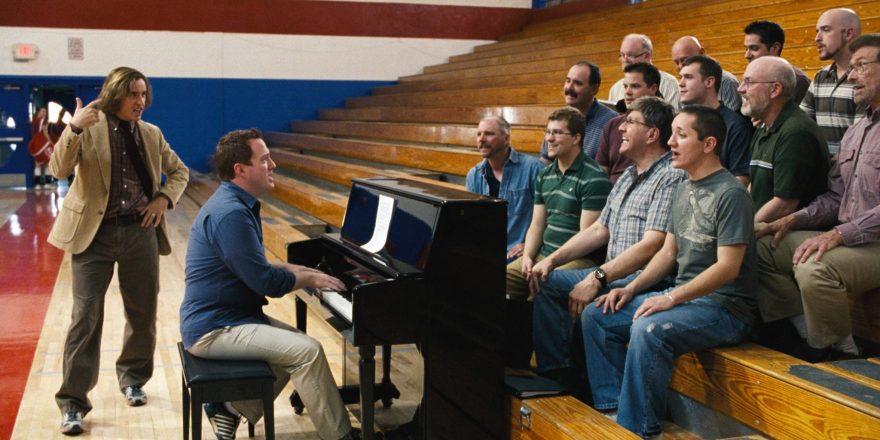Chandra Oppenheim is the frontperson of the Chandra band, a co-founder of the label We Are Time, and an all-around post-punk legend; Nyles Miszczyk is a Toronto-based producer who performs as MISZCZYK, and in Chandra’s backing band. The debut MISZCZYK record, Thyrsis of Etna, was just released by We Are Time, so to celebrate, the two sat down for a chat moderated by Jesse Locke (We Are Time’s co-founder and a member of the bands Tough Age and Motorists, and is in Chandra’s backing band as well). Check it out below!
— Annie Fell, Editor-in-chief, Talkhouse Music
Jesse Locke: Chandra, how did that feel for you when we first got in touch with you back in 2014 about doing this reissue, and coming to Toronto and you playing music?
Chandra Oppenheim: Well, it was like I had waited decades for your call. [Laughs.] From before you were even born, When are they going to call me? I gotta get my career started.
Nyles Miszczyk: What year were those recording sessions? Was that 1981?
Chandra: Yeah, maybe 1980. It was the kind of thing where from when I was 10 years old I had this dream, I’m going to be a rock star, it’s all going to work out and I’m already on that path, it’s definitely happening. And then when I took a pause to do high school and college and I thought, Oh, I’ll just go right back to it and no problem. And obviously that’s not what happened. So I spent years trying to click in again with an audience, and nothing ever caught. And I just kept writing, writing every day for decades.
So I had that. It was still a huge part of my life. I had bands and they broke up, and I had other bands in all different genres, but nothing ever felt that way that the Chandra band felt. And so when there was interest in reviving that, I kind of felt like, finally. Finally I’ll get to perform and there will be an audience, an appreciative audience. They know the songs. They’re singing along, they’re attentive. They’re not talking at the top of their lungs, grabbing beer and going to the bathroom or whatever, you know.
Jesse: Yeah. I’m curious now, how does this experience doing the band again differ from the first time you did it in the ‘80s?
Chandra: Boy, that’s one I have to ponder. I mean, I think that when I did it when I was a kid, it was just a completely natural part of my life. It was just like: I wake up, I have my mom and dad and my stepdad, I go to school and then I go to band practice. It was such a foundational part of my life. So when I would get up on stage and perform it, it was more like, Yeah, okay, this is an extension of that. I’m now having a conversation with these people in this room about my life. But now it’s more like time travel — going back to that time, memories of that. It was dormant, and now it has this new life that we’ve all brought to it. So it feels more like reading a book about my life and sharing that with the audience. And with you guys, too, because there’s an energy to it now. Before it was more like I was standing still at the front of the stage trying to not freak out from nerves, and they were my backing band. Now it feels like we are a band, a whole unit working together. So that’s a different aspect as well.
Jesse: I love that. Nyles, how does it feel for you to be playing this music with Chandra now?
Nyles: Coming into it, I was a little nervous. I’d never really been a hired gun before — almost every single project I had done before was something that I had to initiate, so this was maybe the first time somebody was like, “Do you want to join my band?” And it’s delightful, to be honest with you. It’s so nice not to have to be the driving force of something and making all of the decisions and taking all of the risks, and pressure that I put on myself in the past. By the end of the first practice, I just felt really comfortable and really excited about it. And then, you know, made a lot of lifelong friends because of it, which is great. Most of the people in the band I already knew before it officially became a thing, but not many of them I knew very well. Obviously, Chandra, we had never met before our first band practice, and now it’s just ingrained in my life. And I totally agree with you that it feels like an ensemble more than a hired gun. It’s just my band and I’m in that, and it’s the best.
Jesse: I want to talk about connections to the visual world. Chandra, obviously your dad [Dennis Oppenheim] is a famous artist and you took part in a lot of that stuff, and Andy Warhol painted you when you were a child. You were very involved in the art world. And now [MISZCZYK’s] new album is named after Cy Twombly, Thyrsis of Etna. So is that something that you two connected over, this interest in visual art?
Nyles: Yeah, we’ve definitely had conversations about art and stuff. I think we both greatly appreciate it.
Chandra: Yeah. We haven’t maybe talked a lot about it, but I know that’s one of the things that I appreciate about you, Nyles, is that you are also a visual artist. I love your music, and then I also love your visual art very much.
Nyles: That is so flattering.
Chandra: I’m always hoping you’ll be venturing into that world and having shows.
Nyles: I want to get into that world. The problem is right now, for me, the buy-in price — it’s not like I have paints and brushes and canvases and easels and all that stuff around. Most of what I make is oil pastels, and I like melt them so they kind of look like paint, and I do that on paper. It’s more of something fun that I get to do with my stepdaughter than it is my practice. But I would love to one day develop some kind of art practice. But yeah, right now I’m just focusing on the music stuff.
Jesse: Why did you name your album after the Cy Twombly piece? What is it about that one that you like?
Nyles: It was less after the Cy Twombly piece as much as it’s named after the character Thyrsis of Etna from Virgil’s Eclogues. In Virgil’s Eclogues, Thyrsis and Corydon are two shepherds that have a singing contest. I used to sing in bands and I’ve had my own projects and stuff where I sang, and I did not have to sing anymore — I didn’t sing on this project. It didn’t feel like a contest, but it did feel there’s just a funny parallel that I saw when I found it. I had never heard of Virgil’s Eclogues before seeing Cy Twombly’s Thyrsis of Etna at Hamburger Bahnhof in Berlin. It’s scrawled across it, “I am Thyrsis of Etna, blessed with a tuneful voice.” And so I looked into it and then I read the Eclogues.
What I like about Thyrsis is there’s a kind of… I don’t know if you’d call it a naivete or an overconfidence to him, because basically in the end of it, everyone agrees that Corydon won the contest, but Thyrsis walks away thinking he won. I just found it charming, and the whole thing just felt nice, so I went with it.
Jesse: Yeah. And do you think that represents the concept behind these 16 different vocalists? Like you said, it’s not a contest, but…
Nyles: It’s not a concept record — it’s not like all of the songs were written with the intention of being one whole piece. It’s more like a collection of collaborations. I just gave it a title. It wasn’t really something I was looking to like, Oh, maybe the title of the album can be the rug that ties the room together. It’s just like, you have that running list of interesting words that you string together in some little book, or in the notes in your phone. “Thyrsis of Etna” was probably in there because I was like, I wanna look that up someday. I have a billion little pieces of paper with weird stuff like that on it, whether it’s something I’m supposed to Google or like, Oh, I’m going to call my next band that. Yeah, but it certainly wasn’t some sort of intentional, “This really is a metaphor for the whole thing.”
Jesse: I feel like this is kind of the ultimate We Are Time release in a way, because it’s super intergenerational, and it’s all these people that we’ve met over the last decade of doing this — like Vanessa [Briscoe-Hay] from Pylon, who we met in Barcelona, and all the different members of the We Are Time extended family. Chandra, how do you feel about that aspect of it? The kind of community coming together in one album thing?
Chandra: Yeah, it’s kind of like a dream scenario of Nyles — it’s kind of like you created this space and then invited all these people to come in and play.
Nyles: You nailed it. It’s just like a party. Like friends, friends of friends, a couple complete strangers. It’s just a fun, diverse and interesting crowd of people to spend 45 minutes with.
Chandra: Yeah. And it takes you to all these different places, different mood. I was singing the Letitia [Sadier] one today, and I love being in that space in that song, just driving around and having that as part of my life now. And I feel that way about the record. I was like, Oh, I’m going to put Nyles’s record on today. I need to listen to the whole thing.
Nyles: I definitely intentionally wanted it to be that people sit down and listen to the whole thing. I was very conscientious about trying to get a pleasing experience end to end. And that had a lot to do with why I wanted kind of short songs that were very rapid fire.There’s a couple of times where like it almost feels like blink and you’ll miss the fact it’s a different song now.
But I will say my, favorite context to listen to it is in a car. I love driving at night and listening to it. I don’t have my license — I never learned how to drive, I’ve always been a passenger. So one of my favorite things, because I don’t have to be the one doing the driving, is to be able to pick the music.
Jesse: Yeah, night driving and listening is truly the best. I like this idea of it being a party. It’s kind of like my favorite kind of party, where you invite people from different friend groups and different social circles and they all come together and meet, and new connections are forged through that.
Nyles: Yeah. And I would certainly say that in a lot of ways, Chandra, you are one of the central gravitational forces of the record. And a huge shout out to Marker Starling, Chris Cummings, who I feel like is another big gravitational force. His song, “The Leaves” — when we made that I was in tears. His voice is so beautiful.He introduced me to Laetitia, and Jeremy Singer who’s on the record. And through that I met Corey Hernden. And so there’s these orbits of these two wonderful crowds of amazing people that I really think should know each other in real life. But now they all have something in common. So I hope everybody gets to meet everybody sometime.
Jesse: So the last thing I want to ask you to about is GNDN, your other project. Can you tell me a bit about that? Your new collaborations that you’re working on, and what people can expect from that?
Chandra: Well, I don’t really actually remember how we exactly started talking about doing our own project, just the two of us.
Nyles: I feel like it was a really natural progression, actually.
Chandra: Yeah, I think that’s why I don’t have a memory of it. We were just on tour in the bud, and over time we just finally said, OK, we’re booking a studio.
Nyles: I feel like you can draw a line from Bad Ride [MISZCZYK’s debut EP] to GNDN.
Chandra: Yeah, you invited me to sing on that song. You sent the music and I thought, Gosh, I don’t think I’ve written a song in 10 years or something. And it was so wonderful for me to to realize that I could write something that I liked again, because I had made some attempts and I just thought it was awful. So then I just really shied away from opening up a notebook — and that’s after my whole lifetime writing every day. So it was a fantastic experience to get this music, immediately be inspired. I grabbed lyrics — I went through my archives, piles of notebooks and loose papers from, say, 1983 to 1989, and I immediately found something. I wrote it in about 30 minutes. And then I came to your apartment and we recorded in your living room.
Nyles: Yes, we did. While we had a little gathering — there was five or six other people.
Chandra: People just were showing up and it couldn’t have been more casual, which is the opposite of what I normally put myself through when I record something. So it was really a pleasure. The experience was low pressure, and then it was done.
Nyles: It was so much fun and it happened so fast. I very intentionally made this record as a casual experience. There’s very little revision, very few of the vocals were recorded in “pro” studios. I wanted it, again, just to feel like a party, to be something everybody enjoyed doing. I think it comes through.
I feel like when we recorded “Bad Ride,” it was such a pleasant experience, and then it was like, “Wanna do another” And then we did, that same night I believe, “He Lost It.”
Chandra: Right. That was the jumping off point. And then, actually, my daughter Isa was supposed to record an EP with you, but she just, I don’t know, got cold feet or something. So we had already booked the studio and you had scheduled it, and I said, “Well, OK, I’ll jump in.” And I brought that pile of old lyrics from the ‘80s, from right after the Chandra band and the Chandra Dimension ended. I wanted to pick up where I left off there, so we used those, but then we heavily edited them. And one of the songs we actually, instead of using the lyrics that were on the page, we used a little note that my stepfather had written down — someone’s name and an address. I found that to be more inspiring than the lyrics that were on that page, so that’s our song “Bob Albertson.”
Nyles: Your dad gets co-writing credit.
Jesse: Amazing. And the GNDN EP will be coming out on We Are Time sometime in the future soon, so that’s exciting.
Nyles: And I really think that the GNDN thing, for me, also really plays into the time travel — time is actually on, on Thyrsis of Etna, a real recurring theme that just kind of came naturally. It weighed heavy on everybody’s input without any prompting. I just noticed it. And the intergenerational collaboration aspect. And now with GNDN, we’re reaching back into these notes from 1985 and reconstructing, and suddenly that time is now present to us as we make new objects. It’s been such a fun way to create. It almost reminds me of making a collage — you start with something beautiful, and then you put things together and they start to mean something.
(Photo Credit: left, Kate Young)



